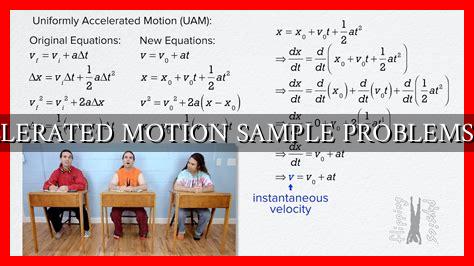-
Table of Contents
UNIFORMLY ACCELERATED MOTION SAMPLE PROBLEMS WITH SOLUTIONS
Uniformly accelerated motion is a fundamental concept in physics that describes the motion of an object with a constant acceleration. Understanding this concept is crucial for solving various problems in physics and engineering. In this article, we will explore some sample problems related to uniformly accelerated motion and provide detailed solutions to help you grasp the underlying principles.
Problem 1: Free Fall
Consider a ball dropped from a height of 100 meters. Calculate the time it takes for the ball to hit the ground assuming acceleration due to gravity is 9.8 m/s2.
- Given:
- Initial velocity (u) = 0 m/s
- Final velocity (v) = ?
- Acceleration (a) = 9.8 m/s2
- Displacement (s) = -100 m (negative sign indicates downward direction)
Using the equation of motion:
v2 = u2 + 2as
Substitute the values:
v2 = 0 + 2 * 9.8 * (-100)
v2 = -1960
v = -44.3 m/s
Now, calculate the time taken to hit the ground using the equation:
v = u + at
-44.3 = 0 + 9.8t
t = 4.53 seconds
Therefore, the ball takes approximately 4.53 seconds to hit the ground.
Problem 2: Car Acceleration
A car accelerates from rest at a rate of 2 m/s2. Calculate the distance it travels in 10 seconds.
- Given:
- Initial velocity (u) = 0 m/s
- Acceleration (a) = 2 m/s2
- Time (t) = 10 seconds
Using the equation of motion:
s = ut + 0.5at2
Substitute the values:
s = 0 + 0.5 * 2 * (10)2
s = 100 meters
Therefore, the car travels a distance of 100 meters in 10 seconds.
Problem 3: Projectile Motion
A projectile is launched at an angle of 30 degrees with an initial velocity of 20 m/s.
. Calculate the maximum height it reaches.
- Given:
- Initial velocity (u) = 20 m/s
- Angle of projection = 30 degrees
- Acceleration due to gravity (g) = 9.8 m/s2
First, calculate the vertical component of the initial velocity:
uy = u * sin(theta)
uy = 20 * sin(30)
uy = 10 m/s
Now, calculate the time taken to reach the maximum height using the equation:
vy = uy + gt
0 = 10 – 9.8t
t = 1.02 seconds
Substitute the time into the equation to find the maximum height:
s = uyt – 0.5gt2
s = 10 * 1.02 – 0.5 * 9.8 * (1.02)2
s = 5.1 meters
Therefore, the projectile reaches a maximum height of 5.1 meters.
Summary
In conclusion, uniformly accelerated motion problems are essential in physics and engineering to analyze the motion of objects under constant acceleration. By understanding the basic equations of motion and applying them to various scenarios, you can solve complex problems related to free fall, car acceleration, and projectile motion. Practice solving sample problems like the ones discussed in this article to enhance your problem-solving skills and deepen your understanding of uniformly accelerated motion.
For more information on uniformly accelerated motion and related topics, you can refer to resources such as Khan Academy.




